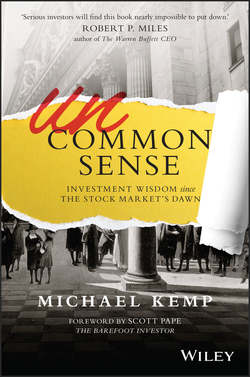Читать книгу Uncommon Sense - Pape Scott - Страница 8
Part I
THE LIMITSOF REASON
1
THE PIED PIPER
ОглавлениеSeveral years ago, while at an investment conference, I got to thinking about why people act blindly on the advice of others. Why do they bestow guru status on their favoured adviser, whether that trust is earned or not? It's a phenomenon I call the ‘pied piper approach to investing'. What got me thinking was a presentation I attended late that afternoon. The guy on stage was trying to convince the audience that all you needed to become a stock-picking superstar was a ruler and a pencil. I'll give you a taste of what he was saying:
Now let's all get trendy. Just hold the ruler against the squiggly lines on the stock chart. Now draw a straight line with the pencil. It's so simple I could get a six-year-old doing this. If the line points up, it's a buy. If it points down, it's a sell. There you go. Now you know how to beat the market.
I don't know how many in the audience accepted his message, but there were plenty taking notes. I'd suggest that few even knew who he was. What then gave this speaker legitimacy? Was it his polished delivery and his tailored suit? I wondered if the audience would see things differently if he spoke with a stutter and dressed like Ronald McDonald. Was his argument strengthened by the simple fact that he was the one on stage, that somebody, unknown to the audience, had considered him enough of an authority to present to us that afternoon?
The reality is that we should always question ‘definitive' financial advice. The mere fact that so much of it is contradictory should alert us to that. And in the case of this presenter I knew there were plenty of views to counter his. Let's start with investment great Ben Graham, who wrote:
Rather extensive studies that we have made of the subject lead us to conclude that reversals of trend in every part of the financial picture occur so frequently as to make reliance on a trend a particularly dangerous matter.2
Or this, again from Graham:
Never buy a stock because it has gone up or sell one because it has gone down.3
Not only did Graham's advice run counter to that of our ‘trendy' presenter, but Graham delivered it in his book The Intelligent Investor, described by Warren Buffett as the best book ever written on the subject of investing.
This example of diametrically opposed advice is just one of many to be found in the finance industry. Why do they exist? If one of two views can be proven to be correct, then only the correct view should be held. And if neither has been proven, then neither should be held passionately and to the exclusion of other views. Where doubt exists nobody should hold any view too strongly. Yet they do.
The problem stems largely from the fact that in the world of finance most things are difficult to prove beyond a shadow of a doubt. And where doubt exists, however small, there will develop a divergence of opinion. The conflict this creates is confusing for those new to investing. We have a natural aversion to contradiction, so to resolve it we choose a single view. Once we've chosen it, we support it with a fervour befitting the one-eyed support of a football team. That's why outspoken pied pipers are so dangerous to follow. They've chosen their team and, armed with their definitive answers, they've become the font of all financial wisdom. But there are two types of people who run a heightened risk of losing money in the stock market: those who know nothing and those who know everything.
Let's extend the whole line-drawing/trend-following argument a bit further.
Drawing straight lines on stock charts supposes that stock prices trend. There are plenty of great minds who've researched trend-following techniques only to find they've come up short. Louis Bachelier, Alfred Cowles, Maurice Kendall, Harry Roberts, Maury Osborne, Holbrook Working, Paul Samuelson, Eugene Fama – the list of researchers who've looked at this issue is nearly endless. All of the aforementioned concluded that ‘getting trendy' is a waste of time. None found enough of a link between historical price data and future price direction to deliver trading profits.
And what about the following comment from Jesse Livermore? His speculative brilliance allowed him to pull millions from the market (and sadly later deliver it all back). Although he died in 1940, Livermore remains a cult hero among traders today. Ironically, this hero of charting zealots had the following to say about charts: ‘Personally, charts have never appealed to me. I think they are altogether too confusing.'4 Which means you would never have found a pencil and ruler guiding Livermore's stock trading decisions.
It seems to me this whole investment game is terribly confused. Professional disciplines such as science and law assume nothing until proven. Yet most ‘investors' are prepared to accept anything stated by someone standing on a stage or presenting on TV.
